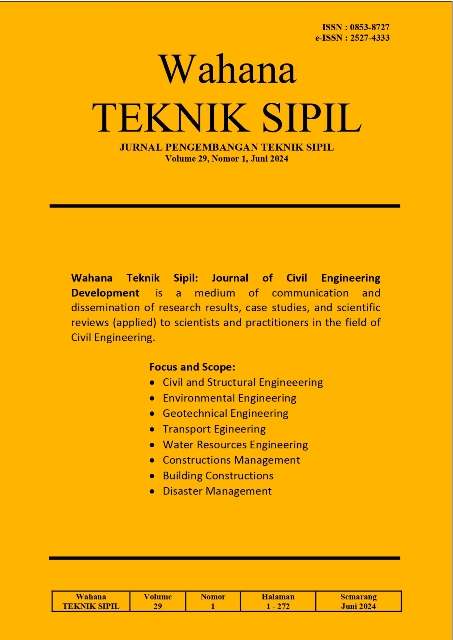ANALISIS DAN EVALUASI PENGEMBANGAN RUTE BUS KAMPUS UNDIP DALAM RANGKA MENUJU TRANSPORTASI YANG BERKELANJUTAN
DOI:
https://doi.org/10.32497/wahanats.v29i1.5658Keywords:
Campus Bus, Performance Evaluation, route development, environmentally friendly infrastructureAbstract
Diponegoro University (Undip) has a total of 67,000 students with high mobility resulting in congestion. Then Undip made an alternative by launching the Undep campus bus. The research aims to identify academic civitas perceptions of campus buses, evaluate campus bus performance based on minimum service standards (SPM), provide improvements in performance evaluation, and make recommendations to campus. The research uses mixed analysis methods, that is qualitative descriptive analysis with dissemination of questionnaires on academic citizens using campus buses as well as using quantitative methods with dynamic data surveys. Based on questionnaire results of identification of perceptions of academic civitas approving campus bus presence, evaluation of performance on physical buses there are 10 corresponding indicators of 20 indicators, bus route evaluation there are campus facilities that are not served and shelter evaluation results there are no information boards. So we need performance improvements to match the current SPM. The result of the recommendations to Undip campus is the development of routes, the need for efficiency of fleet operations at peak hours, improvement of information boards and shelters, repair of bus fleet, and integration of SIAP application with GPS tracking system. Then the development of campus bus routes is needed because there is a demand that has not been served so that more and more academic civitas are using campus buses and need advanced research on the vehicles operating costs (VOC).
References
Harijan., Wisnu, P.P., Ismiyati., & Narayudha, M., 2012, Evaluasi dan Perencanaan Sistem Feeder Jalan Prof. Soedarto, S.H., Tembalang, Semarang. Jurnal Teknik Sipil Universitas Diponegoro.
Humas Universitas Diponegoro, 2022, Undip Fasilitasi Mahasiswa dengan Bus Kampus.
Ismiyati, H.S., 2005, Analisa Model Hubungan Perilaku Pola Perjalanan dan Perkembangan Daerah Pinggiran Berakibat Kemacetan Transportasi Kota Semarang. Research Grant. Teknik Sipil Undip.
Ismiyati, 2011, Mobilitas Transportasi Dikaitkan Dengan Pemilihan Tempat Tinggal Di Kawasan Pinggitan Kota Semarang. [Disertasi, Teknik Arsitektur dan Perkotaan, Universitas Diponegoro].
Keputusan Direktur Jenderal Perhubungan Darat Nomor: 271/HK.105/DRJD/96. Pedoman Teknis Perekayasanaan Tempat Perhentian Kendaraan Penumpang Umum.
Keputusan Menteri Perhubungan Nomor: KM. 35 Tahun 2003. Penyelengaraan Angkutan Orang Di Jalan Dengan Kendaraan Umum.
Nursaidatina, N., 2022, Mengaggas Fenomena Kemacetan di Kampus UNDIP dan Sekitarnya.
Peraturan Menteri Pekerjaan Umum Nomor 03/PRT/M/2014. Pedoman Perencanaan, Penyediaan dan Pemanfaatan Prasarana dan Sarana Jaringan Pejalan Kaki di Kawasan Perkotaan.
Peraturan Menteri Perhubungan Republik Indonesia Nomor PM. 10 Tahun 2012 Standar Pelayanan Minimal Angkutan Massal Berbasis Jalan.
Peraturan Menteri Perhubungan Republik Indonesia Nomor PM 44 Tahun 2019 Perubahan Kedua Atas Peraturan Menteri Perhubungan Nomor PM 46.
Peraturan Menteri Perhubungan Republik Indonesia Nomor PM 98 Tahun 2013. Standar Pelayanan Minimal Angkutan Orang Dengan Kendaraan Bermotor Umum Dalam Trayek.
Purwanto, D., & Ismiyati., 2014, Pengelolaan Transportasi Berwawasan Lingkungan Sebagai Dampak Perkembangan Perkotaan Tak Terkend (Studi Kasus Kota Semarang). Jurnal MKTS, 20, 93-101.
Sufa, F., 2018, Visi Baru Peningkatan Mobilitas di Semarang. Institute for Transportation Development Policy.
Susantono, B., & Sulviawan, A.S., 2012, Pemodelan Rute Bus Kampus Undip Tembalang Dengan Aplikasi Sistem Informasi Geografis (SIG). Jurnal Teknik PWK, 1 (1), 840-854.
Downloads
Published
Issue
Section
License
Authors who publish with this journal agree to the following terms:Authors retain copyright and grant the journal right of first publication with the work simultaneously licensed under a Creative Commons Attribution License that allows others to share the work with an acknowledgement of the work's authorship and initial publication in this journal.
Authors are able to enter into separate, additional contractual arrangements for the non-exclusive distribution of the journal's published version of the work (e.g., post it to an institutional repository or publish it in a book), with an acknowledgement of its initial publication in this journal.
Authors are permitted and encouraged to post their work online (e.g., in institutional repositories or on their website) prior to and during the submission process, as it can lead to productive exchanges, as well as earlier and greater citation of published work (See The Effect of Open Access).






